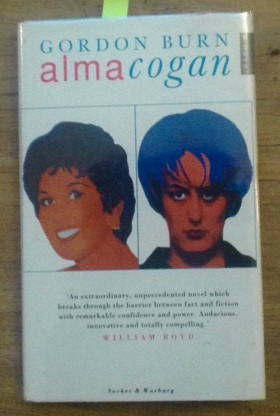Inspiring Older Readers
 posted on 05 Apr 2016
posted on 05 Apr 2016
Alma Cogan by Gordon Burn
Gordon Burn died at the age of 61 in 2009, a victim of bowel cancer. His reputation within parts of the literary and artistic community - domestic and international - was well established by this time but in the wider community he remains largely uncelebrated. Burn was something of a polymath but made his breakthrough writing about real-life crime in a way that elevated criminology above the populist and sensational and imbued the study of British murder - Peter Sutcliffe or Fred and Rose West - with sensibility and intelligence.
Burn is now sometimes talked about as the authentic voice of Northern England and is name-checked by novelists such as David Peace who are very much following in his footsteps. His friendship with Damien Hirst put him at the heart of the Young British Artists at the end of the 20th century and his writing about their work was sharp and perceptive.
But he was also a novelist and his first novel, Alma Cogan, won the Whitbread Prize in 1991. It's a genuinely audacious fiction dressed as a memoir of the 1950s pop star nicknamed 'the girl with the giggle in her voice'. The book is entirely written in the persona of Cogan who Burn takes through her public life in the 1950s and early 1960s and then a period in the 1980s of public retirement spent quietly in a cottage by the sea. All well and good - except that Cogan did in fact die in 1966 of ovarian cancer at the age of 34.
So by imagining the pop star not dying when she did, what Burn creates in reality is the immortal spirit of Cogan who is able to comment on herself and the 'scene' she lived in. It becomes a meditation on the nature of fame and what gets attached by association to the famous. Alma lives a life in the spotlight of fame but also always on the edge of the underworld and its capacity for irrational violence - something the older Cogan is able to look back at with a wry eye.
Burn also takes the opportunity to consider the way in which the glamour of public fame is capable of creating genuine monsters - in this case Myra Hindley and Ian Brady who are tied to Cogan through their ritual use of pop music as part of their preparation for and celebration of each child murder they committed. The book sleeve art shows iconic images of both Alma Cogan and Myra Hindley, yoked together as it were by the spurious notion of fame. The jacket art also serves to help make the contrast in terms of values between the the world of 1950s pop 'stardom' crafted and manufactured into a product and the more sinister new world of the 1960s where - following Warhol's dictum - everyone can be famous for 15 minutes.
The book is only 200 pages long but it's a dense and intense immersion in a fictional psyche that feels both suffocating and, at the same time, utterly convincing. Cogan's career was short but spectacular and her death untimely but what Gordon Burn has done is to give her a chance she never had in reality - the chance to ask whether fame was worth what it drags in its wake and to see first hand what the desire to be famous can do to people.
Terry Potter
April 2016